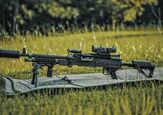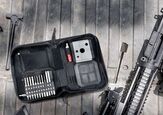The Short-lived RPK-16 Light Machine Gun / Automatic Rifle

The RPK-16 was first unveiled in 2016. It appeared to be a successor to the RPK-74, following the typical design trends in Russian firearms. "RPK" refers to Kalashnikov's hand-held machine gun, commonly categorized as a light machine gun. However, the RPK series, including the RPK-16, is more accurately classified as an automatic rifle.
While it looks like a light machine gun, it lacks many advantages typically associated with a light machine gun. The original intent behind the design of the RPK was to ensure compatibility with the service rifle, which ultimately limited its combat effectiveness. This led to multiple attempts to address these shortcomings in the 1970s Izhmash “Poplin” R&D program for the Soviet Army. This program attempted to improve the light machine gun by the famous improvement range of 1.5 to 2 times and incorporated magazine and belt dual feed systems. Unfortunately, this didn’t lead to any adopted solutions, leaving a vulnerability in Soviet infantry squad firepower until more recently being supplemented with PKMs.
Machine gun shift
After the 2008 Russian intervention in Georgia, military reforms shifted away from the RPK-74, with the PKM taking on a more suitable role. This transition provided infantry units with superior firepower compared to most Western 5.56mm squad automatic weapons, with, in some cases, up to two PKMs per squad. However, this advantage only materializes if the equipment is implemented and utilized correctly. In the current conflict between Russia and Ukraine, the RPK-74 has nearly disappeared from use.
In 2018, I had the opportunity to attend the Army Forum expo and examine some new Russian weapons. The RPK was among the exhibits, but I am not a big fan of the RPK due to its performance limitations. Reports indicated that a light machine gun was developed through a special project to support special units, which required an individual light support weapon. One key requirement for this new weapon was maintaining the same form factor and weight class as the RPK-74 while exceeding its continuous fire capabilities before the barrel needed to cool down to avoid damage and warping.
To meet the requirements, the designers opted for a traditional RPK design, which inherited shortcomings from the original RPK while implementing new features that introduced additional flaws. The RPK's suppressive fire capability is constrained by its magazine feed system and closed bolt design. The limitations of this magazine-fed system reduce the overall ammunition capacity, which impacts the combat loadout and increases the frequency of required reloads to maintain desired levels of suppressive fire. This led to the introduction of a 95-round drum magazine for the RPK-16. While this drum is an improvement over the standard 30 or 45-round magazines, it still does not offer sufficient capacity. Its thin metal construction in the cartridge feed assembly presents several vulnerabilities.
During testing, I observed weaknesses in the design and noted previous repairs at probable failure points within the drums. This might have been a design choice to keep the heavy 5.45mm drum weight down, keeping it lightweight. The desire to enhance suppressive fire capacity raises the risk of 'cook-offs' when operating with a closed bolt system, further limiting the capability of the RPK-16 as a light machine gun. A 'cook-off' is a term used to describe the unintended firing of a round due to the excessive heat of the barrel, which can occur in a closed bolt system.
Another feature added to meeting requirements was incorporating a removable or more accurately described as a configurable barrel system. The designers chose to implement a dovetail locking system. However, this is not a quick-change system but a method for configuring the barrel before use. Upon examining the dovetail locking system, I noticed weak points in the design. Specifically, on the barrel portion of the retaining block, there is a 90-degree shoulder located next to a retaining pin, which is likely to be a failure point.
Due to several shortcomings and failure to meet the minimum requirements set by the Ministry of Defense, Kalashnikov Concern was compelled to develop a new machine gun, the RPL-20. According to Russian news outlets, preliminary factory tests of the RPL-20 were completed in 2024, and the Russian Ministry of Defense plans to conduct state tests in the near future. The RPK-16 has reached the end of its development, necessitating the creation of the RPL-20, which is still ongoing. We will have to wait for the military's state tests to determine the future of the RPL-20. Its adoption could reduce the infantry's combat capability, as the original purpose of the RPK-16 was intended for special forces units for individual light support weapons, a role that the RPL-20 would fit perfectly.
RPK-16 Specifications:
- Caliber: 5.45x39
- Overall length: 33 inches – 35.4 inches (840-900mm)
- Barrel length: 16.33 inches (415mm), 22.8 inches (580mm)
- Capacity: 30, 45-round magazine, and 95-round drum
- Rate of fire: 700-800 rpm
- Weight: 9.9 lbs. (4.5kg)
- Effective range: 600-800 meters

Lynndon Schooler is an open-source weapons intelligence professional with a background as an infantryman in the US Army. His experience includes working as a gunsmith and production manager in firearm manufacturing, as well as serving as an armorer, consultant, and instructor in nonstandard weapons. His articles have been published in Small Arms Review and the Small Arms Defence Journal. https://www.instagram.com/lynndons
More by Lynndon Schooler























![[SHOT 2025] New Thermal Sights from Armasight](https://cdn-fastly.thefirearmblog.com/media/2025/01/23/14281/post.jpg?size=350x220)



Comments
Join the conversation
"After the 2008 Russian intervention in Georgia". That's certainly one way of putting it.
GOOD! I -H A T E- RPK16! I’ll never forgive her!